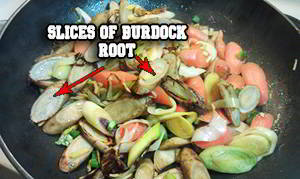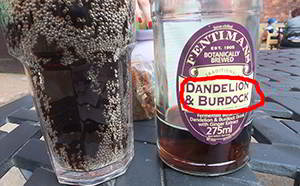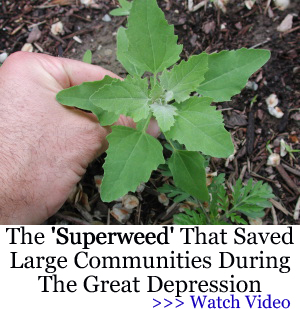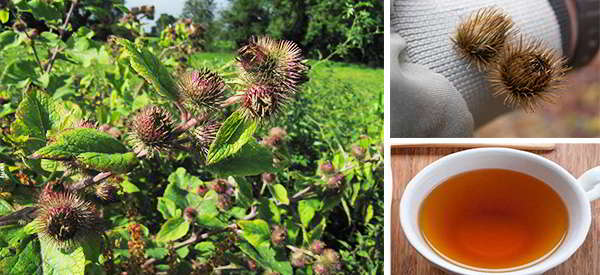If you’ve ever walked through the edges of woodland, passing by tall leafy plants, then looked at your clothes and seen sticky burrs attached, you can bet you’ve just walked pass some burdock. Burdock is a tall plant; it can grow to 4 feet and has purple flowers that blossom in the summer months. Those sticky burrs were the inspiration for Velcro and if you get them on you, you’ll know why.
The best way to deal with this annoying weed?
Eat it!
Burdock is infinitely edible, that is both the plant and the root can be eaten. As a child one of my favorite soft drinks was “dandelion and burdock”. The drink was a horrible brown color, but it tasted great. Burdock is one of those multi-use plants, it is eaten both as a food and used as a medicine.
The uses of burdock as a food and medicine stretch back hundreds of years. For example, Europeans used the plant as an herbal medicine, which we will explore more later on, using original texts. The Chinese and Indians used the plant for a number of complaints including colds and flu. Native Indians in North America would use the plant to treat rheumatism and Shaker communities used it for gout, syphilis and leprosy.
There are other uses for the plant too. The Chinese used burdock for skin complaints such as acne and eczema. There was also a controversial case involving burdock in 50s America. A doctor called Harry Hoxsey had created a number of cancer treatments. The treatments used secret formulas and often contained wild flowers and plants. Hoxsey had a case brought against him by the FDA because of not fully labeling his treatments for cancer, one of which included burdock root. Interestingly, research has continued since then into the use of burdock as a cancer treatment. There’s some interesting further reading here at the University of Maryland Medical Center.
Some Old Times Advise on the Use of Burdock
I am a big fan of lost wisdom. Just because knowledge is from the past, doesn’t mean to say it isn’t still of use. Many of our modern medicines have been derived from the accumulated knowledge of our ancestors. Probably the most famous being aspirin, which was used, in its naturally occurring form of salicin found in willow bark, by ancient Egyptians, who used it for aches and pains.
A quick look through ‘New Dispensatory’, a book of medicinal recipes from 1765, finds a number of uses for arctium or bardanae majoris, the common names for burdock back in the day. It describes burdock as (translated from the original):
“The seeds have a bitterish, subacrid taste. They are recommended as very efficacious diuretics…”
The chapter goes on to describe the taste of burdock root, as
“The roots taste sweetish, with a sight austerity and bitterishness: they are esteemed aperient, diuretic and sudorific”
Related: The 100 Years Old Plant Map That Should Be in Your B.O.B.
Medicinal Recipes:
1. From the New Dispensatory 1765: Decoction of Burdock
“Take of
Burdock roots, two ounces;
Vitriolated tartar, one dram;
Water, three pints.
Boil the water with the roots, so long that the liquor, when strained, may amount only to a quart; to which add the vitriolated tartar.
This decoction is drank to the quantity of one pint per day, as a mild aperient, diuretic and sweetener, for scorbutic and rheumatic complaints.”
For a modern take on the above recipe, substitute ‘vitriolated tartar’ for ‘cream of tartar’ and 1 dram is around 1/8 of a fluid ounce. I’d dissolve a couple of teaspoons of cream of tartar in a small amount of water to get your ‘vitriolated tartar’.
2. Burdock Coffee for Dysentery
The seeds of burdock can be ground and infused like coffee. ‘Burdock Coffee’ is good for dysentery. Here are other five home-made remedies for diarrhea.
3. Decoction of Burdock
You can also create a decoction of Burdock to be used in a similar manner as Burdock Coffee. Decoction’s of burdock are used to treat rheumatism and gout.
To create a decoction you should follow these steps:
- Mash up burdock root
- Boil the mash in water for about 10 minutes
- Strain
- Drink the resultant liquid the dosage being 2 fluid ounces 3-4 times per day
Notes: Sudorific means to cause sweating.
Diuretic makes you pass urine.
Edible Burdock: Some Burdock Recipes for Eating and Drinking
Burdock, especially the root, is a perfect ingredient for all sorts of dishes. However, it is the young burdock that tastes best. For burdock recipes you are best using a first year plant, as after this the burdock is less palatable.
1. Burdock Root Stir Fry
Burdock root forms the basis of this quick and easy recipe:
 Ingredients:
Ingredients:
- A handful of burdock roots
- Handful of other root vegetable such as carrot or parsnip
- Onion or shallot
- Broccoli
- Spinach leaves
- Nuts
- Salt, or spices, such as cayenne pepper, or if available soy sauce
- Finely chopped meat or prawns (optional)
Indications:
- Take your burdock root. Top and tail and peel it as you would a carrot.
- Thinly slice the burdock root and any other root you’re using, lengthways.
- Slice all other ingredients thinly, including any meats
- Add some oil or other grease to a shallow pan
- Heat the oil until it is very hot and spread around the pan
- Place all ingredients in the pan and cook really quickly, the trick to good stir fry is a hot and fast cooking method
You can add a scrambled egg to the stir fry too, once served
2. Burdock Fries
Burdock is lovely roasted as fries in the oven. Top, tail and peel the burdock root. Then slice into fries and place in the oven with oil and salt and cook for about 15 minutes at 450F.
3. Burdock Mash
Top, tail and peel the burdock root. Take some potatoes and prepare them for boiling. Cut the burdock root up as finely as you can. Roast the burdock root and boil the potatoes. Mash the two together with butter and/or milk and a little parsley. Add salt and pepper to taste.
Related: An Awesome 72 Square-Feet SHTF Medicinal Garden Plan
4. And finally, Dandelion and Burdock ‘Pop’ (D&B)
My favorite. Nothing reminds me of childhood as much as this sweet soft drink. This drink is a little like a root beer and somewhat like sarsaparilla. It is an old drink, dating back to the 13th century in England. I doubt that version of D&B would have been anything like my childhood drink. The recipe here is a more modern, sweet version, but you can leave the sweetness out if you prefer, or substitute sugar for honey.

Ingredients
- Dandelion root – several roots, ground up
- Burdock root – 2 large roots, ground up
- Vanilla – either pod (1/2) or essence (1 tsp)
- pinch of cinnamon or all spice
- 1 lemon or lime
- 300g sugar
- 1 pint of water
Indications:
- Make sure the roots are clean.
- Chop the roots up as finely as you can and place them in a pan with the water.
- Add the vanilla pod/essence, cinnamon and lemon juice to the pan
- Boil for about 20 minutes.
- Strain the liquid, removing the roots into a container
- While still warm, add the sugar and stir till dissolved
- You will now have a cordial to dilute to taste
Serve with soda or still water!
You may also like:
 What Happens When the Government Takes Control of Your Food
What Happens When the Government Takes Control of Your Food
Similar to Morphine: The Best Natural Painkiller That Grows In Your Backyard (Video)
DIY Rainwater Harvesting System















The Amish have been using this to treat burns. They not only heal faster, they don’t leave all that ugly scar tissue.
Thanks for the drink recipe!
My mom, born in 1915, told me they used to be called ‘beggar’s buttons’. They were often used by poorer folk to ‘button’ their winter coats. And even people who could afford buttons would use them for a more complete seal on windy, frigid winter days. Most people had to walk wherever they went, even on the worst of days, and these efficient buttons were easily had all winter long. I’ve used them myself on occasion when out hiking, and they work beautifully- well worth it, in spite of the annoying cleanup later! Once I had a wool scarf that was too short to wrap and tie, and kept blowing open, so I hunted down some beggar’s buttons. Wrapped it around my face as best I could and used the buttons to stick the scarf to itself. Was able to finish my chores without my face going numb.
thank you for this story it great to know & share!
Informative and practical uses. not like the handy dandy double duty do all packaging cure all. We need more sites like this. As i retreat from my post i go to vote for you and the rating site thanks again.
Grampa
Thank you!
Growing up in the south we called them “beggar lice” and stuck to everything they touched.
I did not know you could eat the and use them for buttons!
Is this the same as cock a burs?
When I was a kid….some eighty years ago…..we called them “cockle burrs”.
Its amazing how many plants that grow in our yards considered as weeds actually serve a healthful purpose. The challenge is putting them to use in our lifestyles. Thanks for the research.
not the same as cockleburs, both are hateful around livestock. burdock breaks into a million pieces and is extremely difficult to remove from sheeps wool. cocklebur not so much, we spray them here as this is livestock country and they are not welcome. another is called houndstoungue horrible stuff.